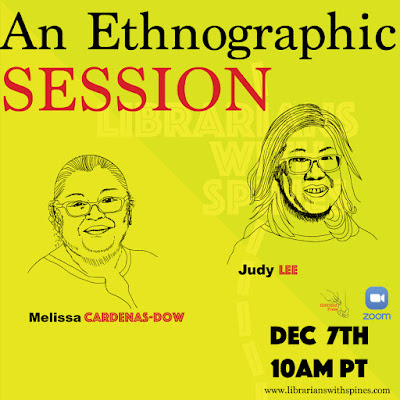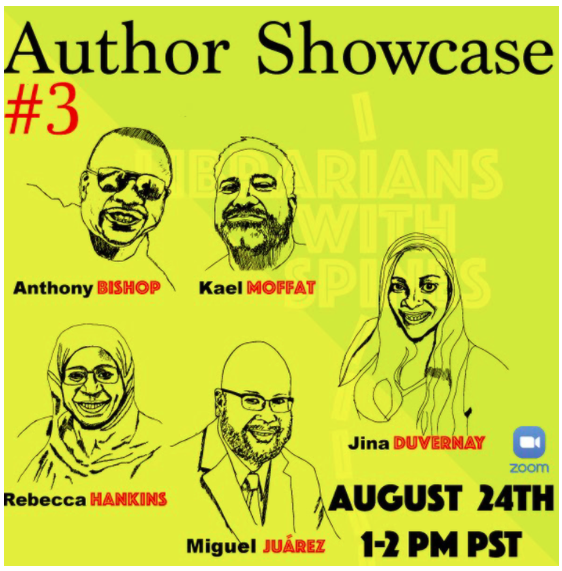Posts
Showing posts with the label Books
San Jose State School of Information Diversity Series: Moving Beyond Diversity to Anti-Oppression
- Get link
- X
- Other Apps
Remembering Consciousness is Power: An Ethnographic Session with Judy Lee and Melissa Cardenas-Dow
- Get link
- X
- Other Apps

[Please share widely!] Please join us! Greetings Friends! We hope you and yours are safe and well. Hinchas Press and Librarians with Spines presents another stimulating session to help you through the pandemic! Please join us in an engaging conversation about ethnographies, scholarship, identity, books, culture and more! Librarians with Spines editors, Yago Cura and Max Macias, Librarians with Spines Designer/Art Director Autumn Anglin Interview Judy Lee and Melissa Cardenas-Dow about their amazing work. Judy and Melissa wrote an amazing chapter in Librarians with Spines Vol. 2 called: LWS2 - Remembering Consciousness is Power: Working to Center Academic Library Outreach in the Service of Social Justice, Asian and Pacific Islander American Ethnic Visibility, and Coalition-Building December 7th, 2020 10am PST on Zoom! Please register for free here: https://www. librarianswithspines.com/post/ remembering-consciousness-is- power-an-ethnographic-session- with-judy-lee-and-meli...
Librarians with Spines Vol. 1 Now available as an Ebook!
- Get link
- X
- Other Apps

I am so proud to announce that Librarians With Spines: Information Agitators In An Age Of Stagnation (or Vol. 1), is now available in an E-book format. The e-book can be found on Amazon, and is responsively formatted, so you can control the font size, etc. with your e-reader. HINCHAS Press is working hard to bring you Vol. 02 in an E-book format by this fall and we plan on publishing Vol. 03 as a print and E-book format together. If you are interested in submitting an abstract or an idea for a chapter in the next book, or as an author on a blog post here, please email Max at librarianswithspines@gmail.com . Librarians With Spines E-book
Book Review: Hip-Hop Family Tree Vols. 1 & 2
- Get link
- X
- Other Apps

I love comics, hip-hop, history and beautiful books. All these things helped form who I am today. As a librarian I still love comics, hip-hop, history, and beautiful books. I feel it is important to cover these aspects in a library collection. Rarely do all these categories come in one work, but this series has it all. I was stoked to receive this collection as a gift, but didn't get around to reading it until now. Amazingly beautiful slipcase! The Hip-Hop Family Tree by Ed Piskor Vols. 1 & 2 exceeds the bar of comics, art, hip-hop, history and beautiful books standards. It will make an invaluable addition to your library collection. This comic is published by the amazing Fantagraphics press . Buy it now --your community will appreciate it. Vol. 1 traces the history of Hip-Hop from the 1970's to 1981. It is filled with little vignettes about seminal figures and events in Hip-Hop history. The stories it tells begin in the bronx with kids ro...
Whiteness in Libraries
- Get link
- X
- Other Apps

Whiteness in US Libraries [Note--this is a blog post. These ideas can and will be further developed. These ideas are sketches of what I am thinking at the moment. Feedback is encouraged and welcome.] US schools and libraries serve as points of diffusion for Whiteness. Whiteness, as used in this post is defined as the concept that European people and European culture are more important than other people and other cultures. Whiteness is purveyed uncritically in libraries. This shucking of Whiteness is done under the guise of objectivity, of adhering the the 'marketplace' of ideas. But this so-called neutrality is really an adherence and capitulation to the Whiteness paradigm. Children of color hear the message of Whiteness--"European people and European culture are more important than other people and other cultures. Children of color live in a world of discrimination and bias in US schools. Some t...
HINCHAS PRESS TO PUBLISH ANTHOLOGY OF ESSAYS ON RADICAL LIBRARIANSHIP TITLED, “LIBRARIANS WITH SPINES” PRESS RELEASE
- Get link
- X
- Other Apps
Please Help Us Publish Librarians With Spines
- Get link
- X
- Other Apps

This is your chance to be part of a unique publishing endeavor. Yago S. Cura and Max Macias are co-editing a book of essays written by specifically invited librarians who we feel have some of the best minds in the world. We need help with funds for publishing. Please consider giving what you can to help us create this one of a kind work. We plan on continuing with a series of unique, forward-thinking and courageous librarian works from outstanding minds in the Information world. My name is Max Macias and my Co-editor is Yago Cura. We are seeking help publishing an invitational anthology of radical essays written by exceptional librarians, many of whom are also librarians of color. All funds will be used for publishing and promotional costs. We are projecting to publish this anthology of essays by May, 2017. Few books have been written about how information and culture impact the creation of knowledge. Even fewer books critique how oppression is bolstered and enhanced by cultura...
Short Review of Between the World and Me
- Get link
- X
- Other Apps

I read Between the World and Me by Ta-Nehisi Coates in one sitting. It was a decent book. Get this book for your library! So many people have already praised it for its great writing and incredible erudition. I felt really let down after reading his book because I was expecting so much more. Mr. Coates is a good writer, but he is not a great writer. His prose flows and I believe he has found his own voice. However, the writing is not beautiful, nor is it creative or innovative in any manner. In my opinion the most important aspects of this book are his insights on the black body. African Americans, after all, were considered products to be exploited for their value as slaves. Their (and latino) bodies are still used in such a way in the prison industry as explicated so brilliantly in Michelle Alexander's seminal work, The New Jim Crow. He COMPLETELY neglects the fact that other ethnicities (besides black people) have race issues in the U...
Citizen by Claudia Rankine (Book Review)
- Get link
- X
- Other Apps

This book is amazing on so many levels. Poetically, it stands almost alone as an example of relationships, alienation, microaggressions, and racism in the 21st century US. Quote from Citizen A friend recommended this book to me over the break--as we were all freshly cut wide open from the Ferguson coverage, revealing local discussions and ongoing murder of POC from any age and area in the US. I finally got a hold of it via the library and read it in earnest. The descriptions of racial microaggressions in 2nd person narrative poetry are so powerful I was shaking as I read them. Quote from Citizen Each page is condensed emotion, reaction and analysis of a lifetime of experiencing relationships that bite while smiling. Her poetry describes how inescapable it is to be a POC in the US at this time and place. The relentless assault upon our senses of 21st century lynchings and their impact the mental health, awareness and identity of POC is explicated in de...
#DiversitiesAndRepresentation
- Get link
- X
- Other Apps
[We welcome this week's guest post from Da` Lyberri-Ann] By: Da’ Lyberri-ann So another Midwinter has passed and like red carpet season, our new literary award winners have been announced with great fanfare. Facebook was filled with selfies and group pictures of committee members proud of a year’s hard work and accomplishments. As a librarian I should feel giddy and excited. New books are winning awards for outstanding literature in many different categories. As a children’s librarian I should be pulling out rolls of golden stickers to note these books of honor and proudly promoting them to my community. But I am not excited or proud. I’m upset. Disappointed. Dare I say “pissed off?”. Why? it is because again I see that although #blacklivesmatter for sound bites in the news, it doesn’t result in actual change. At the risk of pointing out the pink elephant in the room I’ll tell you why: The Caldecott committee didn’t have any people of disadvantaged minority status. ...
Lowriders In Space (Book Review)
- Get link
- X
- Other Apps

How do we get kids to read--especially those that appear to not be interested in reading? Reading! The answer is: find relevant material that the reader can empathize with and that the reader can understand. Back cover of book An adventure making something out of the best of what you have is something ANY kid can empathize with, but the subject matter is most definitely something young Chicanos can relate to and understand. Cars, space, excitement and fun make this dynamic story a great read young readers. This is not to stereotype young Chicanos, we are far more diverse than lowriders, but many of us grew up in Lowrider Culture and love and understand this culture. The language and characters are fantastic, but rooted in Chicanismo. Cathy Camper and Raul The Third have developed friendly, characters who speak much of the vernacular I grew up with as a 3rd generation Chicano in CA. ...
Little to No Progress in Ethnic Minority Representation in ALA, and American Libraries Since 1985
- Get link
- X
- Other Apps

Librarians are NOT representative of the current US Demographics According to my calculations, the ALA had 88.5% White Librarians in 1985, and 87.97% in 2009-2010. According to my calculations, the ALA had 1.8% Asian/Pacific Islander Librarians in 1985, and 2.7% in 2009-2010. According to my calculations, the ALA had 1.8% Latino Librarians in 1985, and 3.08% in 2009-2010. According to my calculations, the ALA had 6.1% African American Librarians in 1985, and 5.19% in 2009-2010. In the US, the above image is linked to the image below. Figures derived from Equity at Issue document from ALA 1985 and ALA office of diversity 2009-2010.


